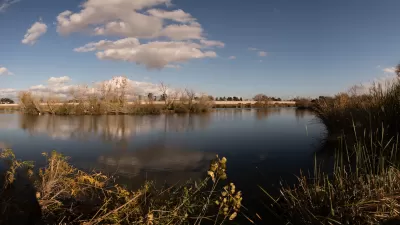A new study reveals that if California could collect and treat more stormwater in cities, it could provide enough water to supply a quarter of the state’s urban population.

Cities across the United States face a range of water challenges, including intensifying impacts of flooding and drought, water scarcity risks, constraints on traditional water supplies facing peak water limits, and water pollution. Innovative ways are needed to address these challenges and improve long-term water resilience.
Stormwater capture is a promising approach. Specifically, It can help narrow the gap between water supply and demand by augmenting and diversifying water supplies. It can also mitigate impacts on communities from intensifying flooding and drought and reduce water pollution. In addition, stormwater capture offers additional co-benefits, such as greening communities and cooling urbanized areas.
As reported by Rachel Becker in this article, a new assessment by the Pacific Institute, in partnership with 2NDNATURE, quantifies the volumetric potential of urban stormwater runoff across the country. The study estimates urban areas have the potential to generate 59.5 million acre-feet of stormwater runoff annually on average. This is equivalent to an annual average of over 53 billion gallons per day. It equals 93 percent of municipal and industrial water withdrawals in 2015, the most recent year with available data.
With respect to California, the analysis found that the Golden State sheds nearly 2.3 million acre-feet of precipitation from pavement, roofs, sidewalks and other surfaces in cities and towns annually. If it were captured and treated, that would be sufficient to supply over a quarter of California’s urban water use or almost 7 million Southern California households each year.
FULL STORY: California’s urban runoff flows down the drain. Can the drought-plagued state capture more of it?

Alabama: Trump Terminates Settlements for Black Communities Harmed By Raw Sewage
Trump deemed the landmark civil rights agreement “illegal DEI and environmental justice policy.”

Planetizen Federal Action Tracker
A weekly monitor of how Trump’s orders and actions are impacting planners and planning in America.

Why Should We Subsidize Public Transportation?
Many public transit agencies face financial stress due to rising costs, declining fare revenue, and declining subsidies. Transit advocates must provide a strong business case for increasing public transit funding.

Understanding Road Diets
An explainer from Momentum highlights the advantages of reducing vehicle lanes in favor of more bike, transit, and pedestrian infrastructure.

New California Law Regulates Warehouse Pollution
A new law tightens building and emissions regulations for large distribution warehouses to mitigate air pollution and traffic in surrounding communities.

Phoenix Announces Opening Date for Light Rail Extension
The South Central extension will connect South Phoenix to downtown and other major hubs starting on June 7.
Urban Design for Planners 1: Software Tools
This six-course series explores essential urban design concepts using open source software and equips planners with the tools they need to participate fully in the urban design process.
Planning for Universal Design
Learn the tools for implementing Universal Design in planning regulations.
Caltrans
Smith Gee Studio
Institute for Housing and Urban Development Studies (IHS)
City of Grandview
Harvard GSD Executive Education
Toledo-Lucas County Plan Commissions
Salt Lake City
NYU Wagner Graduate School of Public Service





























